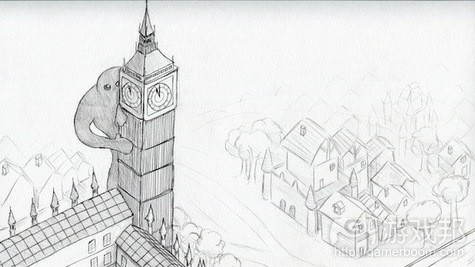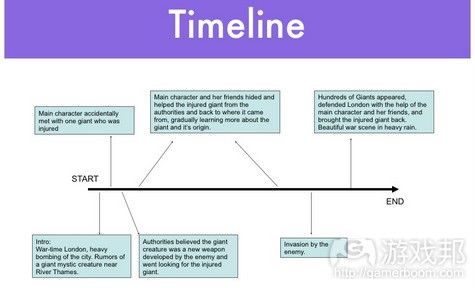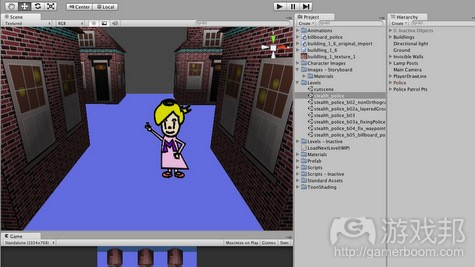《Megan and the Giant》开发者谈自学游戏制作过程
游戏邦注:本文作者是Brandon Wu,他是Studio Pepwuper的CEO,曾担任索尼公司的战略顾问及负责领导EA测试团队。
1年多前,我还在索尼任职,忙于新投资项目的财务预测及评估商业交易。我所负责的是典型的工商管理工作,处理电子表格,撰写可行性研究报告及商业计划书,同高层人员碰面,谈论公司高端计划。这些工作和我目前所做之事风马牛不相及。
我所学的是经济及企业管理,我对编程、2D&3D图像设计或游戏音效或配乐制作一无所知,而且没有任何游戏设计经验。2010年初,我辞掉当时的工作,瞬间变得一无所有,仅存满腔热情及一个游戏构思。疯狂吧?也许有点,但当时我已下定决心无论如何都要制作这款游戏。下面是《Megan and the Giant》这款游戏的制作过程。
构思
2009年12月,我第一次到英国和岳父岳母过圣诞。我和妻子乘坐Duck Tour(游戏邦注:水陆两用车)浏览市区风光。乘坐Duck Tour的过程中,我发现泰晤士河边上有一个路标,上面画着一个庞然大物,然后打着个红红的叉。我们不知道这是什么意思,但我们猜想也许水里住着庞然大物,标识的意思是说“巨型生物禁行”。
我觉得这会是非常有趣的故事,于是随后几天里我将这些构思大致在纸上勾勒出来。我假设英国在同其他国家交战,这些巨人是敌人的秘密武器,但最终他们和其中的小女孩变成朋友,然后帮她保护英国,免受外来入侵。
故事经过多次修改,最后我决定去除战争主题,展现老少皆宜的友好风格。
在某情境中,Megan需帮助巨人摆脱警察的追踪。我最终确定游戏主题:融入《合金装备》和《吃豆人》元素的简单隐蔽类游戏。在粗略把握游戏主题后,我开始着手玩法。起初我将游戏构想成同《雷顿教授》类似的玩法:谜题内容是主玩法,然后在各回合中融入故事内容。
概念画面
在确定基本构思后,我决定制作游戏的概念画面,方便进行开发,及向大家解释游戏内容。我请Shawn Yu帮我制作概念图像。此时我最终确定巨人的外观和个性特点。
设计文稿:演示内容
我决定首先制作游戏的简短演示内容,这样我就能够从中获得些许反馈。我常撰写商业计划,虽然这只是个小项目,但我觉得设计文稿能够帮我完整把握设计内容,发现那些被遗漏的细节。所以我决定撰写设计文稿,描述游戏的故事、玩法、视觉内容、目标用户和样本目标。
外包?
在完成演示内容的设计文稿后,我打算将开发工作外包给第三方,因为我缺乏相关技能(游戏邦注:编程、美工和音效等)。我和全球许多工作室洽谈,发现几家优秀的工作室对此项目非常感兴趣。但他们开出的开发费用都很高,我因此意识到若我想要带领Studio Pepwuper走向成功,掌握游戏制作知识非常重要。在进行1个月的商业开发活动后,我开始埋头学习如何重头制作一款游戏。
游戏引擎
幸运的是,市场存在众多杰出的游戏引擎。我2009年就开始关注这些中间设备,在开发这款iPhone游戏时非常清楚自己所享有的选择,完全能够避开那些基础工作。这些选择包括:Torque、Unity、ShiVa和Cocos2D,我最终锁定Unity 3D,它支持跨平台发行,还有杰出的辅助社区。我购买当时市面上仅有的Unity书籍,然后在随后的1个月里没日没夜地进行研究。此书很好地向入门者介绍引擎知识,但由于我缺乏编程经验,我必须在线阅读众多辅助资料,学习编程和基于Javascript的脚本处理。在这1个月过后,我开始对所有编程人员由衷感到钦佩。
后续进展
我花3个月时间将最初的构思转变成屏幕上的原型,其中大部分的时间主要花在学习编程及把握Unity。看到起初的构思最终栩栩如生地呈现,我心中非常激动,我因此开始觉得自己也许可以投身游戏制作。
原型还不是游戏作品,游戏7个月后才最终完成。(本文为游戏邦/gamerboom.com编译,拒绝任何不保留版权的转载,如需转载请联系:游戏邦)
Making My First iPhone Game From Scratch Part. 1
by Pepwuper’s Brandon Wu
A little more than a year ago, I was working in the strategy division at the Sony headquarters in Tokyo, busy making financial forecasts for new ventures and evaluating business deals. I had a typical MBA job, working with spreadsheets, writing feasibility studies and business plans, and meeting with executives to discuss high level strategies for one of the largest consumer electronics company in the world. My job couldn’t be further away from what I am doing today.
Armed with an education only in Economics and Business, I had no experience with programming a game, creating 2D and 3D art assets, or making sound effects and music for games. Not to mention my lack of proper game design experience. In the beginning of 2010, when I quit my corporate job, I had nothing but a desire to make games, and an idea for the first title. Insane? Maybe, but at that point, I had already decided that, no matter what it took, that game had to be made. Here is the series of events that led to the birth of “Megan and the Giant.”
Conceptualization
In December 2009, I went to England for the first time to visit my in-laws for Christmas. My wife and I went on the Duck Tour – an amphibious bus that takes you around the city, and transforms into a boat that goes into the River Thames. While on the Duck Tour, I saw a road sign near the River Thames that resembled a giant creature, with a red line crossing through it. We couldn’t figure out what the sign meant, and I had the idea that perhaps there are giant creatures living in the river, and that the sign is saying “No Giants Allowed”.
I decided it would make a pretty interesting story, and spent the next few days sketching out ideas of how the story would unfold. I imagined England at war with another country, and these giants were thought to be secret weapons from the enemy, but eventually they became friends with a little girl and helped defending London from an invasion at the end.
The story was modified over time, and eventually I decided to stay away from a war-themed game to keep the game family-friendly.
I kept having this idea where in one scene, Megan would have to help the Giant escape from the police. Eventually I decided that that is what the game would be about, a simplified stealth game with elements from Metal Gear Solid and Pac-Man.After I had a rough idea of what the story was about, I started thinking about gameplay. Initially I imagined a game similar to Professor Layton, where puzzle game is the main gameplay with stories in-between play sessions.
Concept Art
After the basic concept was in place. I decided it would be great to have some concept art for development, and to help explain to people what the game is about. I asked Shawn Yu from Yu’s Art Adventure to help me with the concept art. This is when I finalized the look of the Giant and his personality.
Design Doc: DEMO
I decided to make a short demo for the game first so I could get some early feedback on the game. I used to write business plans, and I thought having a design doc, even though this is a small project, would help me think through the design and find details that I’d missed. So I wrote a design document that described the story, the gameplay, the visual, the target audience, and the purpose of the demo.
Outsourcing…?
After the design document for the demo was done, I wanted to outsource the development to a third party since I didn’t have the skills (programming, art, sound, etc.) to make it. I talked to many studios around the world, and found several talented studios interested in the project. However the development cost was too high, and I also decided that having the knowledge of how a game is made is crucial for me if I want to lead Studio Pepwuper to success. After one month of business development activities, I put my head down and started learning how to make a game from scratch.
Game Engine
Fortunately there are some great game engines available on the market. I had been paying attention to these middleware since 2009 and knew what my options were when it came to developing an iPhone game without having to do all the ground work. Among the choices were: Torque, Unity, ShiVa, and Cocos2D, and I eventually decided on Unity 3D for it’s ability to publish to multiple platforms and it’s supportive community. I bought the only Unity book available at the time (Will Goldstone’s Unity Game Development Essentials) and spent one month studying it day and night. The book does a good job of introducing the engine to beginners, but due to my lack of programming knowledge, I had to supplement my study with lots of reading online to learn programming and scripting with Javascript. I had a new found respect for all the programmers after that intense month.
What’s Next?
It took me three months from the moment I had the idea of making a game to actually seeing the prototype on screen, with the majority of the time spent on learning how to program and finding my way around Unity. It was great to finally see the idea come alive, and to know that maybe, just maybe, I can actually make games!
A prototype is not a game, and the game was still 7 months from completion. Armed with my new-found confidence in self-studying, I continued my journey into more topics involved in game development. In the next part, I will talk about 2D and 3D art, sound/music, level design/boss fights, play-testing, getting the game onto an iPhone (Xcode), and the final crunch to the finish – the much juicier – and rewarding -parts of game making.(Source:gamesauce)
上一篇:论述游戏描述,规则和机制的异同
下一篇:游戏资产管理之设定资产质量标准












































 闽公网安备35020302001549号
闽公网安备35020302001549号